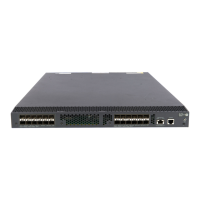• cipher string: Sets a ciphertext shared key. The string argument is case sensitive. In non-FIPS mode,
the key is a string of 1 to 117 characters. In FIPS mode, the key is a string of 15 to 117 characters.
• simple string: Sets a plaintext shared key. The string argument is case sensitive. In non-FIPS mode,
the key is a string of 1 to 64 characters. In FIPS mode, the key is a string of 15 to 64 characters and
must contain numbers, uppercase letters, lowercase letters, and special characters.
vpn-instance vpn-instance-name: Specifies the MPLS L3VPN to which the secondary RADIUS accounting
server belongs, where vpn-instance-name is a case-sensitive string of 1 to 31 characters. If the server is
on the public network, do not specify this option.
Usage guidelines
Make sure that the port number and shared key settings of each secondary RADIUS accounting server
are the same as those configured on the corresponding server.
You can configure up to 16 secondary RADIUS accounting servers for a RADIUS scheme. With the
configuration, if the primary server fails, the device looks for a secondary server in active state (a
secondary RADIUS accounting server configured earlier has a higher priority) and tries to communicate
with it.
Two accounting servers specified for a scheme, primary or secondary, cannot have identical IP address,
port number, and VPN settings.
The shared key configured by this command takes precedence over that configured by using the key
accounting command.
If the specified server resides on an MPLS L3VPN, specify the VPN by using the vpn-instance
vpn-instance-name option. The VPN specified by this command takes precedence over the VPN
specified for the RADIUS scheme.
If you use the secondary accounting command to modify or delete a secondary accounting server to
which the device is sending a start-accounting request, communication with the secondary server times
out, and the device looks for an active server with the highest priority for accounting.
If you remove an accounting server being used by online users, the device no longer sends real-time
accounting requests and stop-accounting requests for the users, and does not buffer the stop-accounting
requests.
For security purpose, all shared keys, including shared keys configured in plain text, are saved in cipher
text.
Examples
# For RADIUS scheme radius1, specify a secondary accounting server with the IP address 10.110 .1.1 a n d
the UDP port 1813.
<Sysname> system-view
[Sysname] radius scheme radius1
[Sysname-radius-radius1] secondary accounting 10.110.1.1 1813
# For RADIUS scheme radius2, specify two secondary accounting servers with the server IP addresses of
10.110 .1.1 a n d 10 .110.1.2 and the UDP port number of 1813.
<Sysname> system-view
50

